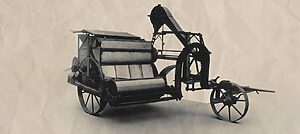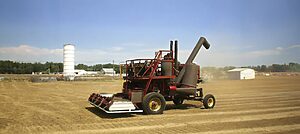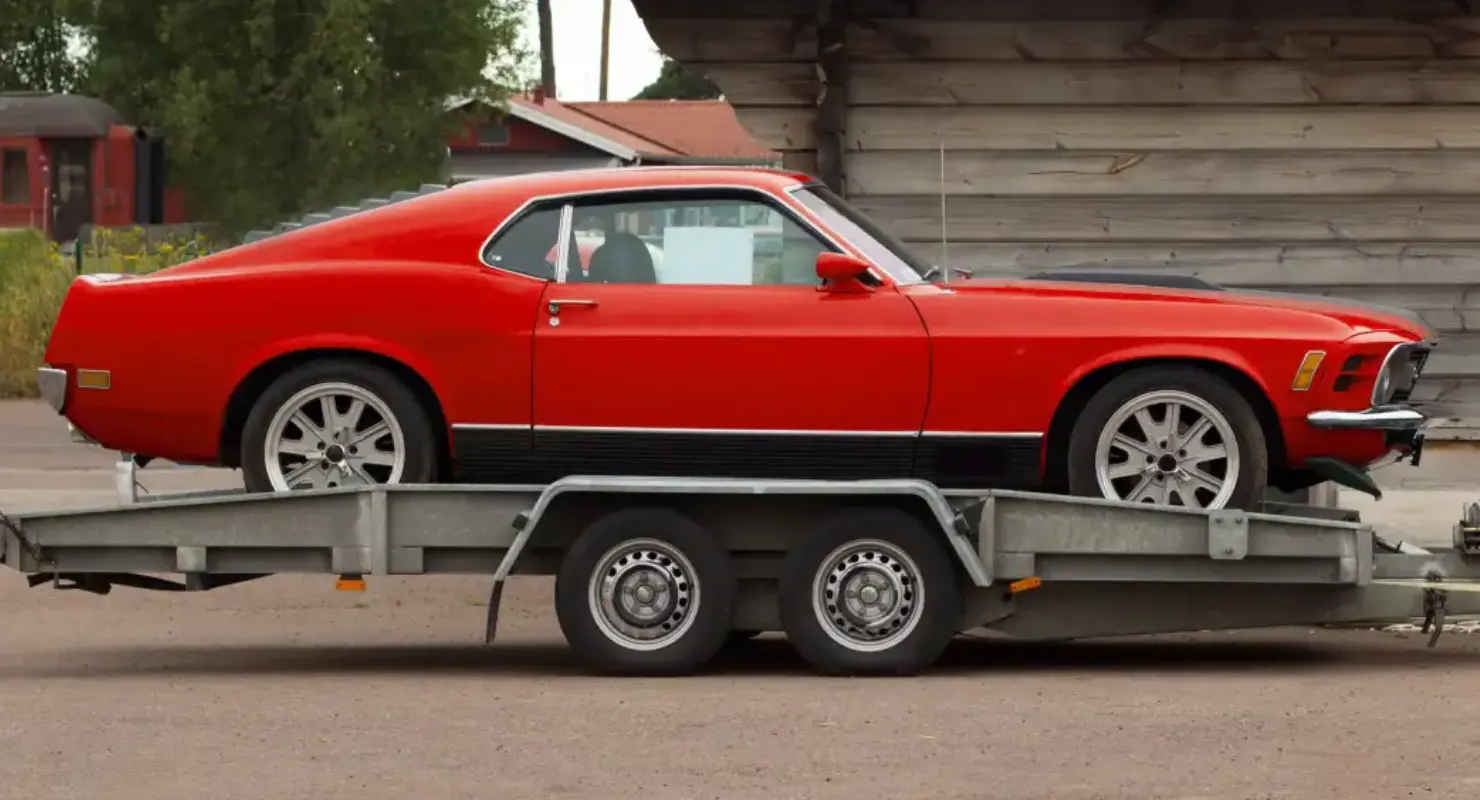
The combine invention transformed what was once a labor-intensive harvesting job into an efficient and easy operation. From its early innovations in the late 19th century to today’s advanced models, the combine has played an important role in feeding people worldwide.
This article explains who invented a combine, why it is called so, and when and where it was made. It also explores the first manufacturers and development of this farm machine.
Atlantic Project Cargo is a freight forwarding company with over 20 years of experience. We offer reliable shipping solutions for harvesters and other types of agricultural equipment. Our company provides a comprehensive approach and ensures safe and timely farm machinery transportation.
What is a Combine Harvester?
A combine harvester, or simply a combine, is an agricultural machine designed to harvest grain crops such as wheat, corn, barley, soybeans, rice, and oats.
The combine is considered one of the most important inventions in farming. It made harvesting faster and reduced manpower. This is the main reason why the combine was invented.
Why is It Called a Combine?
The name “combine” derives from combining three separate harvesting processes:
- Reaping — cutting the crop from the field
- Threshing — separating the grain kernels from the stalks
- Winnowing — cleaning the grain by removing chaff and other debris
Сombining all three operations resulted in the invention of the combine harvester.
Standard harvesters feature the following parts:
- Header
It cuts and gathers the crop - Threshing Drum
Extracts grains from the stalks - Cleaning System
Removes unwanted material - Grain Tank
Stores harvested grain - Unloading Auger
Transfers grain to storage vehicles
Who Invented the Combine Harvester?
The combine harvester’s story began in Scotland in 1826 when Patrick Bell designed a reaper — a prototype of the first combine harvester. This horse-pulled machine used scissors-like blades to cut crops, but Bell never patented it.

The combine harvester inventor is considered to be Hiram Moore. In the 1830s, he and John Hascall built and tested the first combine, patenting it in 1836. To be more precise, in answering the question of where the combine harvester was invented, it was designed in Kalamazoo County, Michigan.
Moore and Hascall’s machine had many features found in modern ones: a cutting blade, a reel to move the grain onto a platform, and a canvas to carry it to a threshing cylinder. Fans and screens cleaned the grain afterward.
Early harvesters were massive machines pulled by mules, horses, or bulls. Hiram Moore’s combine harvester was 17 feet (5.2 m) long with a cut width of 15 feet (4.57 m) and needed up to 30 animals to operate it. A large wheel powered its moving parts as it rolled through the fields.
Stripper Harvester

In early 1884, Hugh Victor McKay built a “stripper harvester” on his father’s farm in Drummarton, Victoria. At the age of 18, he obtained patents for his design in March and June 1885. To bring his invention to farmers, McKay partnered with McCalum, Garde & Co. in North Melbourne to build five harvesters. They were sold to farmers in Victoria and New South Wales for the 1885-86 harvest.
Although McKay’s design wasn’t the first harvester in Australia, his hard work in promoting and improving it made the McKay harvester the most successful Australian design by 1900. The “Sunshine” Stripper Harvester boosted McKay’s reputation as one of Australia’s top makers of farming tools.
It also helped establish Australia as a major producer of cereal crops and became one of the first Australian-made products to be widely exported.
Steam-Powered Harvester
In 1886, California farmer George Stockton Berry added a steam engine to the combine, making it more powerful. Workers tossed straw into the firebox to heat the boiler and keep it running.
The header, or cutter, was over 40 feet (12 m) wide. This machine could cut and thresh more than 100 acres (40,5 ha) a day. It was also less expensive than horse-drawn reapers and stationary threshers. Using a reaper and thresher cost about $3 per acre (4046,86 sq m2) while using the harvester cost between $1.50 and $1.75 per acre.
The Development of Combine Manufacturing

In 1915, International Harvester introduced its first tractor-pulled combines, equipped with an onboard engine to power the threshing mechanism. Then J.I. Case and John Deere released their tractor-drawn combines in the 1920s. After World War I, these combines became popular as tractors became more common on farms.
In 1923, the Curtis brothers and their Gleaner Manufacturing Company patented the first self-propelled combine in Kansas. This design introduced improvements in grain handling and could fit on a truck, making it ideal for traveling harvesters who provide services to farmers.
Australia also saw innovation in 1923 with the Sunshine Auto Header with a Moline tractor engine, one of the first center-feeding self-propelled combines. Created by Headlie Shipard Taylor and H.V. McKay, this machine’s T-shaped design made it narrower and easier to handle, resembling modern combines.

As demand for harvesters grew, manufacturers competed for market dominance. In 1925, Benjamin Holt merged his company with Best to form Caterpillar, which led the market.
To address challenges with harvesting on steep hills, Holt designed adjustable rear wheels that could work on slopes up to 30 degrees. However, in 1936, Caterpillar sold its combine line to Deere&Company to focus on crawler tractors.
The Harvest Brigade
In 1937, Thomas Carroll, working for Massey-Harris in Ontario, developed the commercially successful combine — the lightweight and highly popular Model No. 21, introduced in 1940. It became famous during World War II with the “Harvest Brigade,” an idea created by Carroll.

Massey-Harris asked the War Production Board (WPB) to allow the production of 500 additional machines, promising they would harvest over 15 million bushels (528,586 t) of grain from more than 1 million acres (404,686 ha). This plan would save 500,000 gallons (1,892,706 L) of fuel and release 1,000 tractors for other uses. Farmers buying these combines had to pledge to harvest at least 2,000 acres (809 ha).
The Harvest Brigade began in May 1944, starting with flax in Texas and California’s Imperial Valley, then moving north through the wheat, rice, and barley fields of the Pacific Northwest, northern Texas, and Oklahoma.
By July, the combines swept through Kansas, Colorado, and Nebraska, reaching the Dakotas in August and Canada by September. The campaign boosted the demand for Massey-Harris combines when production returned to normal after the war.
Our company can assist you in shipping new, used, or even antique combine harvesters. We are an experienced provider of international and domestic farm equipment shipping services.
Significant Advancements
In the 1960s, the invention of the self-cleaning rotary screen solved a common issue with combines overheating. Chaff often clogged radiators, blocking airflow and causing engines to overheat. The rotary screen prevented this problem, improving efficiency.
Another major innovation came in 1975 when New Holland introduced the first commercial twin-rotor combine. This new technology allowed faster and gentler grain harvesting.

While companies like Massey-Harris, John Deere, and International Harvester experimented with rotary combines, New Holland was the first to bring the twin-rotor design to market, setting a new standard in harvesting technology.
How Combines Have Evolved

Modern combines can harvest 25 acres (10 ha) of grain per hour, still performing the three main tasks they were designed to do. Unlike early versions that needed a large number of people and animals, today’s combines are operated by just one person.
With advances in technology, modern machines often include cameras and GPS field mapping systems to make harvesting easier and more efficient. Farmers no longer need to climb into the cab to check on operations. Instead, they can monitor each combine’s performance, fuel use, and crop yields, and even make adjustments — all from an iPad, whether in a combine or driving alongside the field.
Conclusion
The invention of the combine harvester became a turning point in agricultural history, improving the harvest process and boosting productivity worldwide. Over time, its evolution from simple, manually operated machines to high-tech equipment has revolutionized farming projects and the management of crops.
At Atlantic Project Cargo, our dedicated team is always here to help you transport your combine harvester or other agricultural equipment. Contact us right now and get your free quote!
Read More



